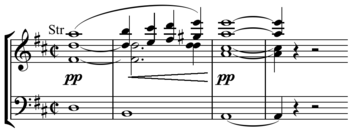Symphony No. 5 (Mendelssohn)
| Symphony No. 5 | |
|---|---|
| Reformation | |
| byFelix Mendelssohn | |
 Drawing of the composer byEduard Bendemann,1833 | |
| Key | D major/D minor |
| Opus | 107 |
| Occasion | Tercentennial of theAugsburg Confession |
| Composed | 1830 |
| Performed | 1832 |
| Published | 1868 |
| Movements | 4 |
TheSymphony No. 5in D major/D minor,Op.107, known as theReformation,was composed byFelix Mendelssohnin 1830 in honor of the 300th anniversary of the Presentation of theAugsburg Confession.The Confession is a key document ofLutheranismand its Presentation toEmperor Charles Vin June 1530 was a momentous event of theProtestant Reformation.This symphony was written for a full orchestra and was Mendelssohn's second extended symphony. It was not published until 1868, 21 years after the composer's death – hence its numbering as '5'. Although the symphony is not very frequently performed, it is better known today than when it was originally published. Mendelssohn's sister,Fanny Mendelssohn Hensel,chose the nameReformationSymphony.[1]
History[edit]
In December 1829, a year before the King ofPrussiaFrederick William IIIhad even announced the tercentennial Augsburg celebrations, Mendelssohn began work on the Reformation Symphony. Mendelssohn hoped to have it performed at the festivities in Berlin which took place on 25 June 1830. He had intended to finish the composition by January 1830 and tour for four months before the celebrations began in June. However, his ill health caused the Reformation Symphony to take longer to compose than he had initially expected. In late March the symphony was still in a state of fabrication, and in an inauspicious turn of events Mendelssohn caught measles from his sisterRebecka.With a further delay of the composing and touring, Mendelssohn eventually completed the symphony in May. Unfortunately, it was too late for the Augsburg commission to recognize the symphony for the celebrations.
Some authorities have suggested thatantisemitismmay have played a role in the symphony's absence from Augsburg. But the successful competitor,Eduard Grell,had already established himself as a competent and successful composer who was gaining considerable popularity in Berlin. Grell was extremely conservative in his compositions; his piece for male chorus perhaps matched what the Augsburg celebrations demanded, in contrast to Mendelssohn's extensive symphony, which may have been thought inappropriate at the time.[2]
Mendelssohn resumed his touring immediately after he had completed the Reformation Symphony. In Paris, in 1832,François Antoine Habeneck's orchestra turned the work down as 'too learned'; the music historian Larry Todd suggests that perhaps they also felt it to be too Protestant.[3]He did not offer the symphony for performance at London. During the summer of 1832, Mendelssohn returned to Berlin where he revised the symphony. Later that year a performance of the Reformation Symphony finally took place.[4]By 1838 however Mendelssohn regarded the symphony as 'a piece ofjuvenilia', and he never performed it again. It was not performed again until 1868, more than 20 years after the composer's death.[5]
Key[edit]
Thekeyof the symphony is stated asD majoron the title page of Mendelssohn's autograph score. However, only the slow introduction is written in D major, whereas the main theme and thecadencesetting of the first movement are inD minor.The composer himself referred to the symphony on at least one occasion as in D minor.[6]
Instrumentation[edit]
The symphony is scored for 2 flutes, 2 oboes, 2 clarinets, 2 bassoons, "serpente"andcontrabassoon(fourth movement only, now usually played on the contrabassoon alone),[7]2 horns, 2 trumpets, 3 trombones, timpani and strings.
Movements[edit]
| External audio | |
|---|---|
| Performed by theBerlin PhilharmonicunderHerbert von Karajan | |
The symphony is in four movements:
- Andante–Allegrocon fuoco (D major–D minor)
- Allegrovivace(B-flat major,trio inG major)
- Andante (G minor,ending in G major)
- Andante con moto – Allegro vivace – Allegromaestoso(G major – D major)
A typical performance lasts about 33 minutes.
First movement[edit]
During the slow introduction, Mendelssohn cites the "Dresden Amen"on the strings. Mendelssohn's version of the" Dresden Amen "is as follows:
(The "Dresden Amen" was also adapted byRichard Wagneras the "Grail"leitmotifin his 1882 operaParsifalor byAnton Brucknerin the finale of hisFifth Symphonyand the adagio of theNinth.)
The strings are interrupted by battle-cries from thebrasssection as follows:

The "Dresden Amen" soon reappears on the strings and theAllegro con fuocosection, which is insonata form,then begins. It opens as follows:
Second movement[edit]
The second movement, a B-flat majorscherzo,is very different in spirit from the first movement, being much lighter in tone.
Third movement[edit]
The third movement, in G minor, is a lyrical piece primarily for the strings. There are references to the "Dresden Amen", and, at the movement's end, to the second theme of the first movement.
Fourth movement[edit]

The fourth movement is based onMartin Luther'schorale"Ein feste Burg ist unser Gott"(" A mighty fortress is our God "). It is insonata formand is mostly in4
4time.There are a few unmarkedmeterchanges to2
4to fit the meter of the original chorale.[8]At the very end of thecoda,a powerful version of Martin Luther's chorale is played by the entire orchestra.
Notes[edit]
- ^Citron, Marcia J. (1987).The Letters of Fanny Hensel to Felix Mendelssohn.New York: Pendragon Press. pp. 97, 99, 101.ISBN0-918728-52-5.
- ^Silber (1987),322–4
- ^Todd (2003), 254
- ^Silber (1987),331–2
- ^Silber (1987),333
- ^Silber (1987),329
- ^Douglas Yeo(2021). "serpent".An Illustrated Dictionary for the Modern Trombone, Tuba, and Euphonium Player.Dictionaries for the Modern Musician. Illustrator: Lennie Peterson. Lanham:Rowman & Littlefield.p. 128–31.ISBN978-1-538-15966-8.LCCN2021020757.OCLC1249799159.OL34132790M.WikidataQ111040546.The Italian term for the serpent instrument wasserpentone;Mendelssohn very likely wrote for theEnglish bass horn,a form of upright serpent popular at the time.
- ^Kirill Polyanskiy's analysis of Mendelssohn's Fifth Symphony
References[edit]
- Heuss, Alfred. 1904. "The 'Dresden Amen': In the First Movement of Mendelssohn's 'Reformation' Symphony."The Musical Times45, no. 737 (4 July): 441–42.
- Silber, Judith. 1987. "Mendelssohn and His 'Reformation' Symphony."Journal of the American Musicological Society40, no. 2 (Summer): 310–36.
- Taylor, Benedict. 2009. 'Beyond Good and Programmatic: Mendelssohn's 'Reformation' Symphony',Ad Parnassum,7/14 (October 2009): 115–27.
- Todd, R. Larry. 2003.Mendelssohn – A Life in Music.Oxford; New York: Oxford University Press.ISBN0-19-511043-9.
External links[edit]
- Symphony No. 5:Scores at theInternational Music Score Library Project






